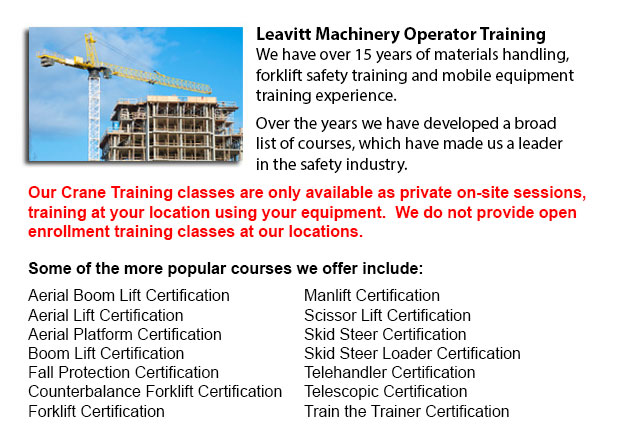
Prince Albert Crane Certification - The Crane Certification training program includes subject matter suggested by industry concerning the efficient and safe operation of cranes. Individuals training would be taught the following: how to identify cranes and their component parts; pre-operational, operational and post-operating requirements; rigging components and inspection/rejection criteria; how to determine overall lift capacity; and needs specific to the work site where the individuals training will be working.
The requirements which should be carried out before operating a crane includes assigning authority for the pre-operational check; doing the sequential pre-operational check based on the manufacturer's specifications or specifications certified by a professional engineer; checking the log book for comments; checking the work area for obstacles and hazards; checking cables, hooks, chains crane movement and safety latches; making sure of the proper functioning of operational controls; and learning how to make sure that the disconnect switch/isolator of the crane is properly working.
The requirements to operating a crane will consist of the identifying of responsibilities and roles, and the determination of the need for a formal lift plan. The person training will learn how to do hazard assessments for the different environmental conditions, physical conditions and staff. Subject matter includes determining when to seek competent help, the safest route and destination of loads, and load weight and centre of gravity.
People training must be able to identify an over-capacity lift, in addition to be able to select correct rigging machinery, choose load limitations, and to determine the safe spot for the crane to operate from. Trainees will review both universal and site-specific crane signals for lifts, and methods for traveling, lifting and loading. Correct maintenance practice would likewise be included.
Trainees would be evaluated on their knowledge of the need for emergency response procedures for different conditions like for example an electrical or mechanical failure. They will be asked to describe shut down and parking procedures for security and safety, to follow lock out and tagging techniques, and to explain why near misses are recorded and reported to the appropriate person. Log book records should be maintained.
The trainee would be taught the particulars of rigging, and be taught the responsibility and authority for rigging. They will learn to identify the different types of rigging, storage procedures and the load capacity ratings.
Post-operational requirements comprise entering deficiencies or defects, service and maintenance history in the log book, based on provincial, federal and state codes requirements.
Site-specific requirements can be incorporated into the safety training program according to the employer's requirements.
-
Prince Albert Forklift Training Courses
Prince Albert Forklift Training Courses - When forklift operator safety training is tailored for illiteracy, training time is lessened by 50 percent. Lift-truck operator driver safety training evaluation, train the trainer and forklift training certi... More -
Prince Albert Heavy Equipment Training
Prince Albert Heavy Equipment Training - The two most common kinds of heavy equipment training are classed into the categories of equipment; equipment which is fashioned with rubber tires or those with tracks. The tracked vehicle are heavy duty machi... More -
Prince Albert Order Picker License
Prince Albert Order Picker License - Order preparation operation or order picking as it is more usually known is a method utilized within warehouse operations and comprises staff called order pickers. The order picker's duty is to take and collect ar... More -
Operator Safety Training, Re-Qualification Training, In-House Instructor Training in Prince Albert
Used in nearly all warehouse operations, boat yards or industrial construction sites, the lift truck is a very important part to be able to help raise and transfer cargo. The reach feature of a lift truck can help improve the applications which the f... More -
Prince Albert Overhead Crane Certification
Prince Albert Overhead Crane Certification - The overhead crane training certification program is designed to be effective with all those participating regardless of language or literacy restrictions. The course has two parts: a practical training se... More -
Prince Albert Heavy Equipment Training Programs
Prince Albert Heavy Equipment Training Programs - There are different types of equipment that are ready to be utilized at any given time on a construction site. These equipment require mechanics to be able to complete the maintenance tasks, operators... More -
Prince Albert Crane Operator Certification
Prince Albert Crane Operator Certification - The process to allow individuals to operate specific kinds of cranes is to take crane operator certification training to be given certification. The certification process consists of classroom learning, ha... More -
Prince Albert Crane Safety Training
Prince Albert Crane Safety Training - Both crane driver as well as their employers should know all the possible issues associated to the use of an overhead crane. All over North America, there is legislation that provides regulation for the safe oper... More

Forklift Certification Prince Albert
TOLL FREE: 1-888-254-6157
Prince Albert, Saskatchewan
forkliftcertificationprincealbert.com
Email Us
About Us


